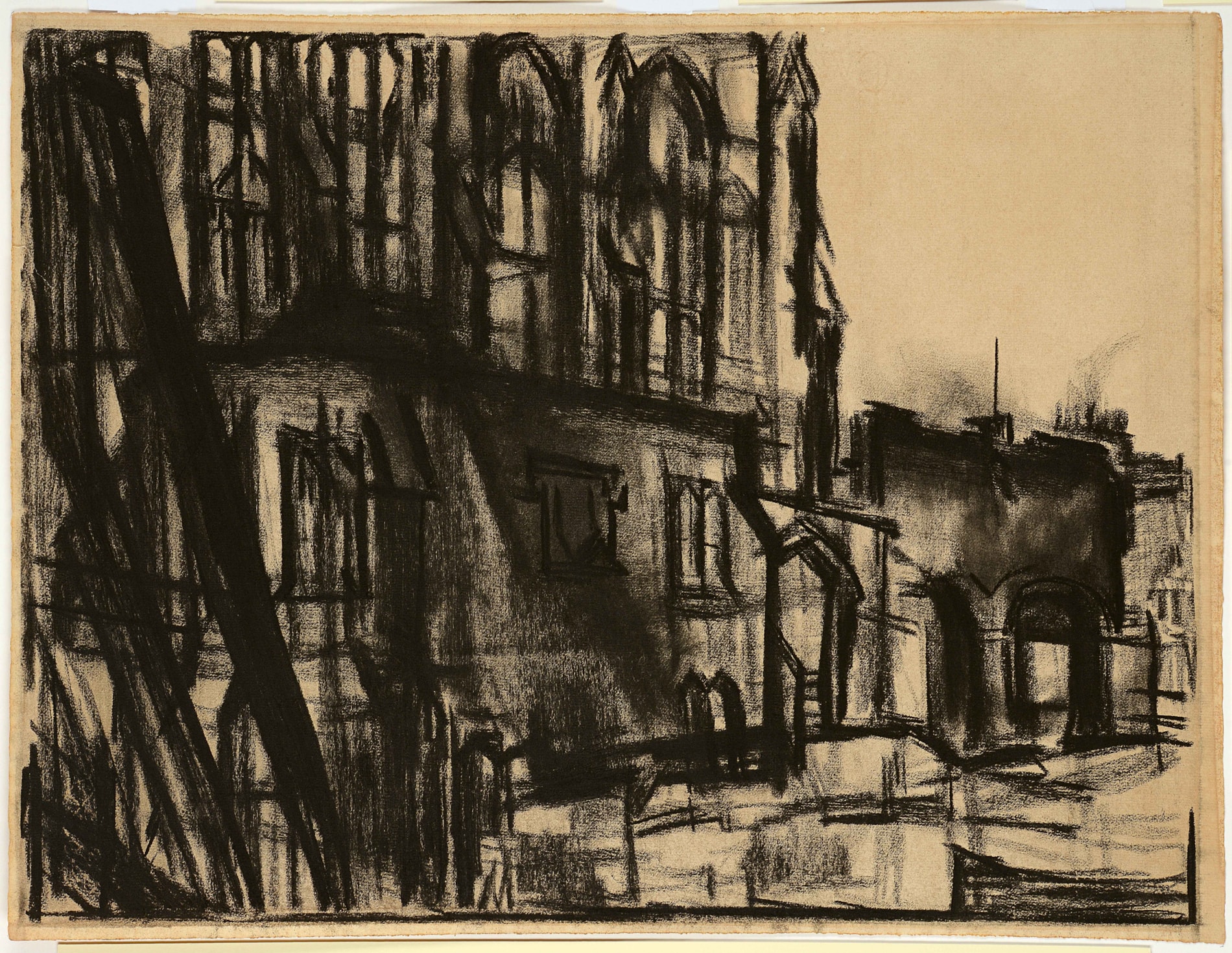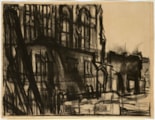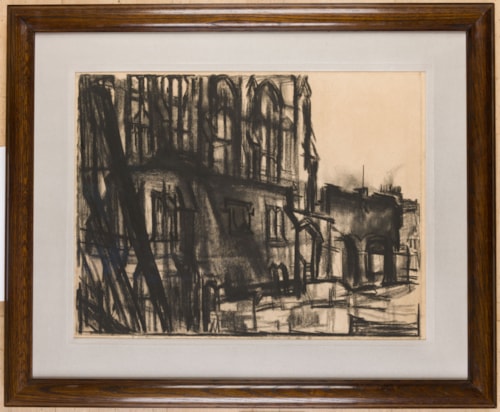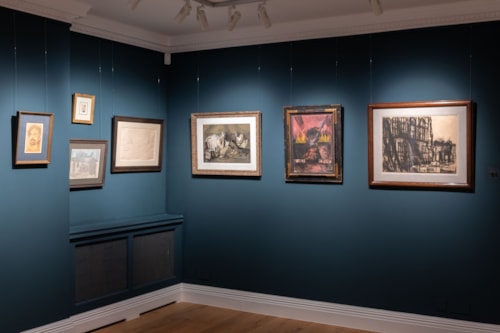David BOMBERG
(Birmingham 1890 - London 1957)
Middle Temple
Charcoal on light brown paper.
Inscribed Authenticated by Lilian Bomberg. / London Series. / Possibly [crossed out] SOUTH Middle Temple. / by David Bomberg/ LB in blue ink on the verso.
475 x 622 mm. (18 3/4 x 24 1/2 in.) [sheet]
Inscribed Authenticated by Lilian Bomberg. / London Series. / Possibly [crossed out] SOUTH Middle Temple. / by David Bomberg/ LB in blue ink on the verso.
475 x 622 mm. (18 3/4 x 24 1/2 in.) [sheet]
Drawn in 1947, this large charcoal study is one of several large-scale drawings David Bomberg made of the cityscape of London both during and after the end of the Second World War. As the Bomberg scholar Richard Cork has written of these powerful works, ‘He reduced his draughtsmanship to its most skeletal in order to convey the gutted, sooty wreckage of a metropolis battered almost beyond recognition by Nazi bombing-raids. Charcoal was the ideal medium for the purpose.’
Bomberg had begun making these charcoal cityscape drawings around 1944, when he had served as a firewatcher in Kensington. As the artist’s biographer William Lipke has written, ‘While standing watch on long dark nights, he became more and more intrigued with the monumental buildings that had withstood many centuries. Deciding at last to begin that series of sketches that would record London’s historic monuments blackly silhouetted against the sky, he turned to his favourite drawing medium, charcoal. With its rich, velvety texture the artist drew out the firmness of the architecural forms, yet rubbed in the pervading darkness like a thin haze covering the inky night...This experience left an indelible stamp on his mind, and later he would return to examine the architectural heritage of London more closely after peace was restored.’
Bomberg had envisaged publishing a book of these drawings. As he wrote to the Ministry of Works in October 1945: ‘I am working on a series of drawings that will form when co-ordinated a panorama of London – to be reproduced and published in London.’ As Cork notes, however, ‘Like so many of Bomberg’s projects, the scheme never reached fruition: his style was too stark to attract publishers interested in topographical surveys of the city. But the drawings themselves remain, testifying to the compassion with which he surveyed the battered remains of a city whose skeletal structure lends itself well to Bomberg’s defining line.’
Bomberg’s drawings of this type led to his appointment to teach a weekly drawing class at the Bartlett School of Architecture in London. The artist had shown some of his cityscape drawings to the eminent architect Sir Charles Reilly, who in a letter of December 1944 recommended him to the Bartlett as a teacher: ‘I have been looking at Mr David Bomberg’s drawings of great masses of buildings, and feel he has something valuable to convey to the young architectural student. He has extraordinary powers of giving a sense of mass and it is on its mass and volume a modern building so much relies. He could help therefore the young architect...If I had charge of a school still I should like Mr Bomberg to take a sketching class for me, feeling he would help the student to get at the meaning of the mass composition of the building rather than of their detail, and that is what is wanted.’
The Honourable Society of the Middle Temple, generally known as Middle Temple, is one of the four Inns of Court in the City of London, along with the adjoining Inner Temple, Gray’s Inn and Lincoln’s Inn. The Middle Temple is the western part of the ‘Temple’; the building that served as the English headquarters of the Knights Templar until the order was dissolved in 1312. This drawing depicts the bomb-damaged main church at Middle Temple. As the present sheet has been recently described, ‘The architectural mass almost entirely fills the sheet, recalling Giovanni Battista Piranesi’s eighteenth-century etchings depicting imagined subterranean spaces. Incomplete walls and empty windows, undarkened by Bomberg’s furious shading, eliminate the solidity that defined [a drawing of the same site] three years earlier. Now the walls of Middle Temple appear wavering and skeletal, more akin to scaffolding than centuries old stone. Bomberg invites contemplation of the monumental and deeply historic made fragile to deliver an unexpected poignancy only heightened by the brusque handling.’
Bomberg also made a number of large charcoal drawings of late 12th century round Temple Church at Middle and Inner Temple, which are stylistically comparable to the present sheet, and of similar dimensions. These include a drawing of The Round Church at Middle Temple which appeared at auction in 1983 and another with Fischer Fine Art Art in London in 1988, and a third with Marlborough Fine Art in in 1967 and Piano Nobile and Gerrish Fine Art in 2017.
This large drawing is one of around a dozen works by Bomberg acquired by the singer, musician and actor David Bowie (1947-2016) for his personal collection. As Bowie once stated, ‘I’ve always been a huge David Bomberg fan. I love that particular school. There’s something very parochial English about it. But I don’t care.’
Bomberg had begun making these charcoal cityscape drawings around 1944, when he had served as a firewatcher in Kensington. As the artist’s biographer William Lipke has written, ‘While standing watch on long dark nights, he became more and more intrigued with the monumental buildings that had withstood many centuries. Deciding at last to begin that series of sketches that would record London’s historic monuments blackly silhouetted against the sky, he turned to his favourite drawing medium, charcoal. With its rich, velvety texture the artist drew out the firmness of the architecural forms, yet rubbed in the pervading darkness like a thin haze covering the inky night...This experience left an indelible stamp on his mind, and later he would return to examine the architectural heritage of London more closely after peace was restored.’
Bomberg had envisaged publishing a book of these drawings. As he wrote to the Ministry of Works in October 1945: ‘I am working on a series of drawings that will form when co-ordinated a panorama of London – to be reproduced and published in London.’ As Cork notes, however, ‘Like so many of Bomberg’s projects, the scheme never reached fruition: his style was too stark to attract publishers interested in topographical surveys of the city. But the drawings themselves remain, testifying to the compassion with which he surveyed the battered remains of a city whose skeletal structure lends itself well to Bomberg’s defining line.’
Bomberg’s drawings of this type led to his appointment to teach a weekly drawing class at the Bartlett School of Architecture in London. The artist had shown some of his cityscape drawings to the eminent architect Sir Charles Reilly, who in a letter of December 1944 recommended him to the Bartlett as a teacher: ‘I have been looking at Mr David Bomberg’s drawings of great masses of buildings, and feel he has something valuable to convey to the young architectural student. He has extraordinary powers of giving a sense of mass and it is on its mass and volume a modern building so much relies. He could help therefore the young architect...If I had charge of a school still I should like Mr Bomberg to take a sketching class for me, feeling he would help the student to get at the meaning of the mass composition of the building rather than of their detail, and that is what is wanted.’
The Honourable Society of the Middle Temple, generally known as Middle Temple, is one of the four Inns of Court in the City of London, along with the adjoining Inner Temple, Gray’s Inn and Lincoln’s Inn. The Middle Temple is the western part of the ‘Temple’; the building that served as the English headquarters of the Knights Templar until the order was dissolved in 1312. This drawing depicts the bomb-damaged main church at Middle Temple. As the present sheet has been recently described, ‘The architectural mass almost entirely fills the sheet, recalling Giovanni Battista Piranesi’s eighteenth-century etchings depicting imagined subterranean spaces. Incomplete walls and empty windows, undarkened by Bomberg’s furious shading, eliminate the solidity that defined [a drawing of the same site] three years earlier. Now the walls of Middle Temple appear wavering and skeletal, more akin to scaffolding than centuries old stone. Bomberg invites contemplation of the monumental and deeply historic made fragile to deliver an unexpected poignancy only heightened by the brusque handling.’
Bomberg also made a number of large charcoal drawings of late 12th century round Temple Church at Middle and Inner Temple, which are stylistically comparable to the present sheet, and of similar dimensions. These include a drawing of The Round Church at Middle Temple which appeared at auction in 1983 and another with Fischer Fine Art Art in London in 1988, and a third with Marlborough Fine Art in in 1967 and Piano Nobile and Gerrish Fine Art in 2017.
This large drawing is one of around a dozen works by Bomberg acquired by the singer, musician and actor David Bowie (1947-2016) for his personal collection. As Bowie once stated, ‘I’ve always been a huge David Bomberg fan. I love that particular school. There’s something very parochial English about it. But I don’t care.’
The son of a Polish immigrant, David Bomberg was apprenticed to a lithographer as a youth, but was determined to establish himself as an artist. He took evening classes at the Westminster School with Walter Sickert and at the Central School of Arts and Crafts, and in 1911 was admitted into the Slade School of Art, aided - as were his fellow pupils Isaac Rosenberg and Mark Gertler - by a loan from the Jewish Education Aid Society. At the Slade he was a student of Henry Tonks and Fred Brown, alongside Paul Nash, William Roberts, Stanley Spencer, Edward Wadsworth and Christopher Wynne Nevinson. Like many of his fellow students, Bomberg was fascinated by his exposure, at such events as Roger Fry’s two Post-Impressionist exhibitions at the Grafton Gallery, to the work of Cézanne, Matisse and Picasso, as well as to such radical artistic movements on the Continent as Cubism and Futurism. A trip to Paris resulted in encounters with Picasso, Modigliani and Derain, and Bomberg was invited by Wyndham Lewis to exhibit with the Vorticist Group in London.
In 1914 the young artist, aged just twenty three, and a year out of the Slade, was given a large one-man exhibition at the Chenil Galleries in Chelsea, which generated much critical comment. After a period of military service in the First World War, first with the Royal Engineers and later as an infantryman on the Western Front, Bomberg produced a major painting of Sappers at Work for the Canadian War Memorials Fund in 1919. In the 1920s he began to travel to Spain and Palestine, and these trips resulted in a number of superb landscape paintings and drawings.
A period spent in Spain in the 1930s, where Bomberg lived in the rugged mountains of the remote and somewhat isolated province of Asturias, was immensely fruitful, but the outbreak of the Spanish Civil War forced him to return to London at the end of 1935. During the Second World War, a commission from the War Artists Advisory Committee led Bomberg to a bomb store in a disused mine near Burton-on-Trent, where he made numerous drawings and oil sketches of the site in 1942. (The bomb store was destroyed in 1944 in a massive explosion - the largest ever recorded in Britain - caused by the accidental detonation of a bomb and the chain reaction that followed.) Between 1945 and 1953 Bomberg worked as an art teacher at the Borough Polytechnic, where among his students was Frank Auerbach and Leon Kossoff. He was a gifted and much admired teacher, and several of his pupils formed the Borough Group, with Bomberg as its figurehead and leader.
Despite his early successes before the First World War, Bomberg struggled for recognition as an artist throughout his later career. He lacked a dealer who could champion and promote his work, and did not even figure in Herbert Read’s book Contemporary British Art, published in 1951. Indeed, the only significant survey exhibition of Bomberg’s work to be held after the First World War was a relatively modest show of thirty-seven works at the Heffer Gallery in Cambridge in 1954. In the same year he returned to Spain, hoping to set up an art school in the mountaintop city of Ronda in Andalusia. Although this never came to pass, many of Bomberg’s students visited him in Ronda and painted there. It was not until just after his death, when the Arts Council organized a retrospective exhibition of his work, that Bomberg achieved a measure of recognition. Only in the 1980s, however, with the publication of an important monograph on the artist by Richard Cork and a major exhibition of his work at the Tate Gallery, has Bomberg’s reputation been firmly established. He is today regarded, both as an artist and as a teacher, as a highly significant figure in 20th century British art.
In 1914 the young artist, aged just twenty three, and a year out of the Slade, was given a large one-man exhibition at the Chenil Galleries in Chelsea, which generated much critical comment. After a period of military service in the First World War, first with the Royal Engineers and later as an infantryman on the Western Front, Bomberg produced a major painting of Sappers at Work for the Canadian War Memorials Fund in 1919. In the 1920s he began to travel to Spain and Palestine, and these trips resulted in a number of superb landscape paintings and drawings.
A period spent in Spain in the 1930s, where Bomberg lived in the rugged mountains of the remote and somewhat isolated province of Asturias, was immensely fruitful, but the outbreak of the Spanish Civil War forced him to return to London at the end of 1935. During the Second World War, a commission from the War Artists Advisory Committee led Bomberg to a bomb store in a disused mine near Burton-on-Trent, where he made numerous drawings and oil sketches of the site in 1942. (The bomb store was destroyed in 1944 in a massive explosion - the largest ever recorded in Britain - caused by the accidental detonation of a bomb and the chain reaction that followed.) Between 1945 and 1953 Bomberg worked as an art teacher at the Borough Polytechnic, where among his students was Frank Auerbach and Leon Kossoff. He was a gifted and much admired teacher, and several of his pupils formed the Borough Group, with Bomberg as its figurehead and leader.
Despite his early successes before the First World War, Bomberg struggled for recognition as an artist throughout his later career. He lacked a dealer who could champion and promote his work, and did not even figure in Herbert Read’s book Contemporary British Art, published in 1951. Indeed, the only significant survey exhibition of Bomberg’s work to be held after the First World War was a relatively modest show of thirty-seven works at the Heffer Gallery in Cambridge in 1954. In the same year he returned to Spain, hoping to set up an art school in the mountaintop city of Ronda in Andalusia. Although this never came to pass, many of Bomberg’s students visited him in Ronda and painted there. It was not until just after his death, when the Arts Council organized a retrospective exhibition of his work, that Bomberg achieved a measure of recognition. Only in the 1980s, however, with the publication of an important monograph on the artist by Richard Cork and a major exhibition of his work at the Tate Gallery, has Bomberg’s reputation been firmly established. He is today regarded, both as an artist and as a teacher, as a highly significant figure in 20th century British art.
Provenance
Marlborough Fine Art, London, in c.1967
Anonymous sale, London, Sotheby’s, 25 May 1983, lot 142
Anonymous sale, Sotheby’s London, 18 January 1984, lot 208
Redfern Gallery, London
Anonymous sale, London, Sotheby’s, 8 March 1995, lot 121 (bt. Bowie)
David Bowie, London and New York.
Anonymous sale, London, Sotheby’s, 25 May 1983, lot 142
Anonymous sale, Sotheby’s London, 18 January 1984, lot 208
Redfern Gallery, London
Anonymous sale, London, Sotheby’s, 8 March 1995, lot 121 (bt. Bowie)
David Bowie, London and New York.
Literature
London, Piano Nobile, Bomberg/Marr: Spirits in the Mass, exhibition catalogue, London, 2017, pp.32-33, no.11 (entry by Sean Ketteringham).
Exhibition
London, Marlborough Fine Art Ltd., David Bomberg 1890-1957: Drawings and watercolours, n.d., (1967?), no.29; London, Piano Nobile, Bomberg/Marr: Spirits in the Mass, exhibition catalogue, London, 2017, no.11.






